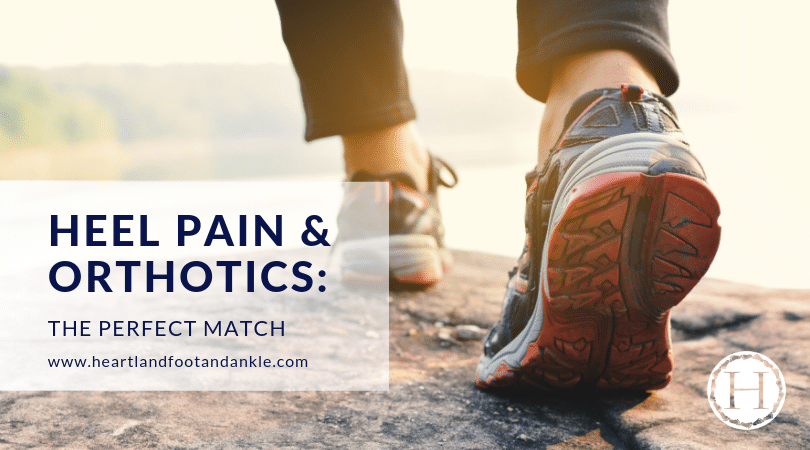Heel Pain and Orthotics: The Perfect Match
If you suffer from heel pain, you are not alone. Studies have shown that each year more than 2 million Americans also deal with the same problem. And that is why we are here to help you kick this annoying setback to the curb!
The human foot and ankle are comprised of 26 out of the 206 bones which make up our body structures. Additionally, all their muscles, ligaments and tendons easily push this number of anatomical components into the hundreds.
The complex anatomy of our feet allows us to not only sustain our bodyweight and give us balance, but is also strong enough to propel our bodies forward as we walk, run, and dance. All the while, the lower appendages employ extreme flexibility, which helps our feet to instantly adapt to sudden surface changes as our bodies tread throughout this unstable world.
Our heels, in particular, bear most of these stressors – when we stand, walk, and run, our heels are usually the first part of our feet to come into contact with the ground. As our heels repeatedly absorb the sudden shock of impact, pain can begin to arise, at times even making it difficult to complete simple routine tasks like walking to your car or wearing your favorite pair of shoes.
Although mild discomfort in the heel doesn’t necessarily indicate serious health issues, the problem can develop into a more urgent situation if it’s ignored. And you know what they say: “an ounce of prevention is better than a pound of cure.”
What is Causing Your Heel Pain?
We’ve already mentioned that heel pain is commonly a result of the hindfoot undergoing repeated impact during activities. However, there are also other factors which may lead to heel pain and discomfort. Here are some common causes:
- Our feet can endure up to 4 times our bodyweight in physical forces, especially during high-impact activities like running or jumping. This means that if your bodyweight is higher than average, then your feet and ankles are also under greater pressure – which can lead to pain.
- Bearing weight for long periods. Standing for excessive periods of time can cause heel pain. This is especially true with hard flooring or surfaces.
- High-impact activities. Although already mentioned, it is worth being mentioned again – repetitive high-impact activities like jogging and dancing exert greater amounts of shock impact to the heels, which can then cause discomfort and pain.
- Ill-fitting footwear. Wearing shoes that provide poor shock absorption and support – especially during high impact activities – is actually one of the main causes for heel pain. Instead, opt for supportive shoes.
Wearing appropriate footwear, however, can minimize – if not altogether eliminate – heel pain.

Sole Mates – Orthotics Made for Your Heels
In many cases, simply using orthotics can relieve some of the strains brought about by the daily forces exerted on our feet, especially our heels. The American Orthopedic Foot and Ankle Society recommends the use of orthotics – even if they are over-the-counter – coupled with a simple stretch regimen to significantly reduce heel discomfort and pain.
However, with all the different varieties in orthotics, it can be somewhat stressful finding the perfect one to address your issue. So, here are some things to consider before going on the hunt for your “sole mate”:
- All orthotics are different. It is important to understand that not all orthotics are the same – they vary in material, design, and quality. Your best course of action is to visit a podiatrist before making a decision, but it is still a good idea to at least do some research on the topic before purchasing orthotics in order to determine which type will be most beneficial to your situation.
- Orthotics which are well-manufactured will usually be firm enough to provide arch support and “cushiony” enough to absorb the shock of impact during activities. While rigid orthotics can help in realigning certain areas of the foot and ankle, they can sometimes lead to pain in different areas of your feet and legs – and this will be counterproductive. For that reason, we take special care to consider the overall picture when prescribing and customizing your orthotics.
- On the other hand, orthotics that are too “cushiony” – though super comfortable at first – do not provide long-term support and stability for your feet and ankles. The best option regarding orthotic rigidness/cushion is to find a good balance between the two – not too rigid, not too “cushiony” will be your best bet.
- Finding the right size for you is also vital. The best route in this case is to purchase orthotics which are sold in a variety of sizes rather than the usual “small, medium, and large” options (which are most common). In order for orthotics to actually be effective, it must closely match your shoe size and arch. Again, this is a reason it’s so important to come into our office for a pair that’s customized to your unique foot structure and gait patterns.
- Check with a podiatrist. Finally, if you are still uncertain as to what type of orthotic is best for you, check with a podiatrist. A professional – like you can find on our staff – will be able to point you in the right direction and answer any lingering questions. It may even be the case where the best option for you is to be prescribed your own pair of custom orthotics, which are molded specifically to your needs.
We Can Help You Decide
If you are ready to put an end to heel pain, or just need more information on what orthotics may be best for you, give us a call at (309) 661-9975 to schedule an appointment with our Illinois podiatrist, Dr. Lockwood.
